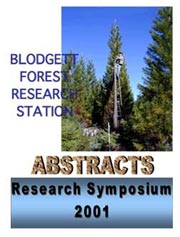 |
||||||||||||||
|
||||||||||||||
| 2001 Blodgett Forest Research Symposium |
| Research Projects | Research Publications | Back to TABLE OF CONTENTS |
|
|||||||||||||
The tendency for diseased forest trees to suffer more insect damage than healthy trees is well known, but the biochemical changes that mediate this effect are largely unknown. In general, knowledge of the systemic interactions between forest trees, fungal pathogens and insects lags that of herbaceous plant systems. In order to contribute to the understanding of the chemical interactions between fungal root pathogens, conifers and bark beetles, two hypotheses were tested: 1) root infection of ponderosa pine induces systemic changes in phloem phenolics; and 2) these changes affect beetle feeding behavior. Concentrations of soluble phenolics and lignin in the phloem of ponderosa pines inoculated with the pathogen, Heterobasidion annosum, were followed over a period of two years in a 35-year-old plantation at Blodgett Forest Research Station. The major effect of the pathogen on phloem soluble phenolics consisted of a significant accumulation of ferulic acid glucoside: 503 ng/mg FW, compared with 366 ± 26 ng/mg FW for mock treated and 386 ± 27 ng/mg FW for control trees. There was a reduction in lignin content of the cell walls, and lignin content was negatively correlated with ferulic acid glucoside concentration. While ferulic acid glucoside did not stimulate or inhibit Ips paraconfusus feeding in an artificial medium, it is hypothesized that lower lignification may facilitate the growth of beetle-associated fungi, resulting in greater susceptibility of the host to bark beetle colonization.
|
|||||||||||||
Contact Author: Pierluigi Bonello, Department of Plant Pathology, The Ohio State University, 201 Kottman Hall, 2021 Coffey Road, Columbus, OH 43210, USA, e-mail: bonello.2@osu.edu, Tel.: (614) 688-5401, Fax (614)-292-4455 A.J. Storer, W.R. McNee, and D.L. Wood Division of Insect Biology, 201 Wellman Hall, University of California, Berkeley, CA 94720, USA T.R. Gordon Department of Plant Pathology, 1 Shields Ave., University of California, Davis, CA 95616, USA W. Heller Institut für Biochemische Pflanzenpathologie, GSF-Forschunszentrum, Neuherberg, Postfach 1129, D-85758 Oberschleissheim, Germany |
|||||||||||||
|
|||||||||||||
|
University of California Center for Forestry, UC Berkeley. Last modified: 6/27/02 ©Copyright, 2001. The Regents of the University of California. For questions and comments, contact webmaster. |






